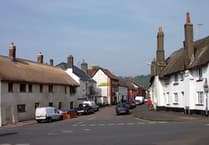While thousands of youngsters from across the South West completed their two-day Ten Tors challenge, 14 members of the club set out from Lowery Cross near Burrator to walk their own ten tors, a distance of about 9.5 miles. It was a mild day and after the initial mist and low-lying cloud lifted, the sky cleared, and the sun came out for much of the day.
There was a little light rain for the final mile or so but otherwise it was a dry and pleasant day out. The terrain was typically moorland with soft green downs, rocky tracks and lovely ancient woodland all liberally sprinkled with Devon violets throughout the walk. After the recent rains, there was surprisingly little boggy ground and mud.
With a splendid view overlooking Burrator Reservoir our first tor, the lesser-known Lowery Tor which is found at the bottom of Peek Hill, is no longer marked on modern OS Maps. It was first mentioned by William Crossing in his Guide to Dartmoor. Burrator Reservoir was built in the 19th century in response to the population growth of Plymouth. Building began in 1893 taking five years to complete. Sharpitor which looks like the teeth of a saw was one of the locations used for the filming of War Horse. There are nearby wartime installations. The tor was bought by the DPA in 1984 and five boundary stones inscribed with their initials were erected. Leather Tor is a steep and rocky ridge and not easy to climb so the walkers stayed on the lower reaches. The word leather probably derives from the Anglo-Saxon world hlead meaning steep hill or cliff. Nearby is a stretch of Devonport Leat built in the 1790s to carry fresh drinking water from Dartmoor to the expanding Plymouth Dock renamed Devonport in 1824. Just above the leat is a late Neolithic age platform cairn and cist. The cist, also known as a kistvaen, is a stone burial chamber enclosed by granite slabs topped with a large cover stone. There is evidence of mining activity in the area at Keaglesborough Mine which closed in 1810. The route continued crossing Leather Tor Bridge which was built in 1833 at the site of the medieval Riddipit Steps.
The displaced stones can still be seen although three of them have been displaced by floods. Continuing down a stony track the group passed the potato cave of Leather Tor Farm, first mentioned in the 14th century, and last used in 1924. The cave, which would have been used for storing root crops, was abandoned when the reservoir was built. The walkers next passed by Middleworth, Snappers, Little Down and Down Tors before climbing up and skirting the side of Sheepstor. This huge granite outcrop with a sheer face is beloved by climbers. On the top is a Pixies House (or Piskies). It is possible to go into the cave and be hidden is from view. The walkers continued over Sheepstor Dam where the river Meavy flows into the reservoir. Here the group enjoyed ice creams before climbing up to Yennadon Down visiting both Burra Tor and finally Claig Tor which has visibly altered from the original as granite from here was used in the construction of the dam.
For further information see ‘Dartmoor Tors’ Compendium by Josephine M Collingwood.
As ever, new walkers are always welcome. You should be suitably attired for all weather conditions, including sturdy footwear and bring a drink and a packed lunch.
Meet at the post office in George Street, Okehampton on Sundays ready to leave at 9.30am. Next week the walk will begin at Blackaton Cross. Members share cars so please be at the post office in plenty of time so the group can leave promptly. Car drivers with spare seats are encouraged to meet at the post office to offer lifts to non-drivers.




